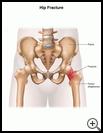
Hip Fracture
________________________________________________________________________
KEY POINTS
- A hip fracture is a break at the upper end of your thighbone where your thighbone meets your pelvic bone.
- You may need surgery though sometimes the bone can heal with rest and physical therapy.
- Follow the full course of treatment prescribed by your healthcare provider. Also, try to make your home safe from accidents to prevent falls and injury.
________________________________________________________________________
What is a hip fracture?
A hip fracture is a break at the upper end of your thighbone where your thighbone meets your pelvic bone.
Hip fractures are a serious injury. Most hip fractures happen to people over 65 years old. They are more common in women than men.
What is the cause?
Hip fractures usually result from a fall. You are more likely to break your hip if you have osteoporosis. Osteoporosis is a thinning and weakening of the bones that can happen as you get older. Other diseases, such as cancer and kidney disease, may also weaken bones and make it easier for them to break.
What are the symptoms?
Symptoms may include:
- Severe pain in your hip or groin
- Not being able to put any weight on your injured leg
- Stiffness, bruising, and swelling in your hip
- A leg that has gotten shorter or turns inward or outward
If you fall and cannot get back up, someone should call 911 or an emergency medical service right away. No one should try to move you until medical help arrives.
How is it diagnosed?
Your healthcare provider will ask about your symptoms and medical history and examine you. Tests may include:
- X-rays
- Bone scan, which uses a small amount of radioactive chemical injected into your blood to make detailed pictures of your bones
- CT scan, which uses X-rays and a computer to show detailed pictures of the bones
- MRI, which uses a strong magnetic field and radio waves to show detailed pictures of the bones
How is it treated?
You may need surgery. To repair your broken hip, your surgeon may:
- Put a metal rod through the center of the bones so that they line up and come back together. This is the most common way to repair a hip fracture.
- Put in plates and screws to hold the broken pieces together.
- Replace the broken bone with an artificial hip joint.
In some cases, the bone can heal without surgery. In this case, your healthcare provider may prescribe pain medicine, bed rest, and physical therapy for a few weeks to allow healing.
How can I take care of myself?
Follow the full course of treatment prescribed by your healthcare provider. Ask your healthcare provider:
- How and when you will get your test results
- How long it will take to recover
- If there are activities you should avoid and when you can return to your normal activities
- How to take care of yourself at home
- What symptoms or problems you should watch for and what to do if you have them
Make sure you know when you should come back for a checkup.
Use a cane or walker as directed by your healthcare provider.
How can I help prevent a hip fracture?
Doing what you can to prevent osteoporosis can help prevent hip fractures. For example:
- Eat a healthy diet. Foods such as low-fat milk and dairy products, green leafy vegetables, citrus fruits, sardines, and shellfish can help you get calcium. Calcium helps your bones stay healthy. Ask your healthcare provider about the best way for you to get the right amount of calcium and vitamin D every day.
- Get regular weight-bearing exercise. Strengthening your muscles as well as your bones can help prevent falls and injury. Ask your healthcare provider if there are any limits on your exercise.
- If you smoke, try to quit. Talk to your healthcare provider about ways to quit smoking.
- If you want to drink alcohol, ask your healthcare provider how much is safe for you to drink.
- If you take antacids regularly, ask your provider which ones are safe for you to take. Talk to your healthcare provider about other ways to lower your risk of osteoporosis.
Using your body wisely when you do everyday tasks may help prevent hip fractures. For example:
- When lifting heavy objects, bend your legs rather than your back when you pick up something from the floor. Hold objects close to your body when lifting them.
- Avoid unusually vigorous physical activity. Build your activity level slowly.
- Wear shoes that provide good support, such as shoes designed for running or walking.
- Use support for walking, such as a cane, if you need it. When you are getting out of a chair, put your weight over your feet and slide to the front of the chair. Then, using the arms of the chair, raise yourself to a standing position.
- Try to make your home safe from accidents to prevent falls and injury. For example, install handrails in the bathroom and remove loose rugs. Keep items you could trip over--like electric cords, oxygen tubing, clothing, and craft items (like yarn)--off the floor or out of common walking areas.

